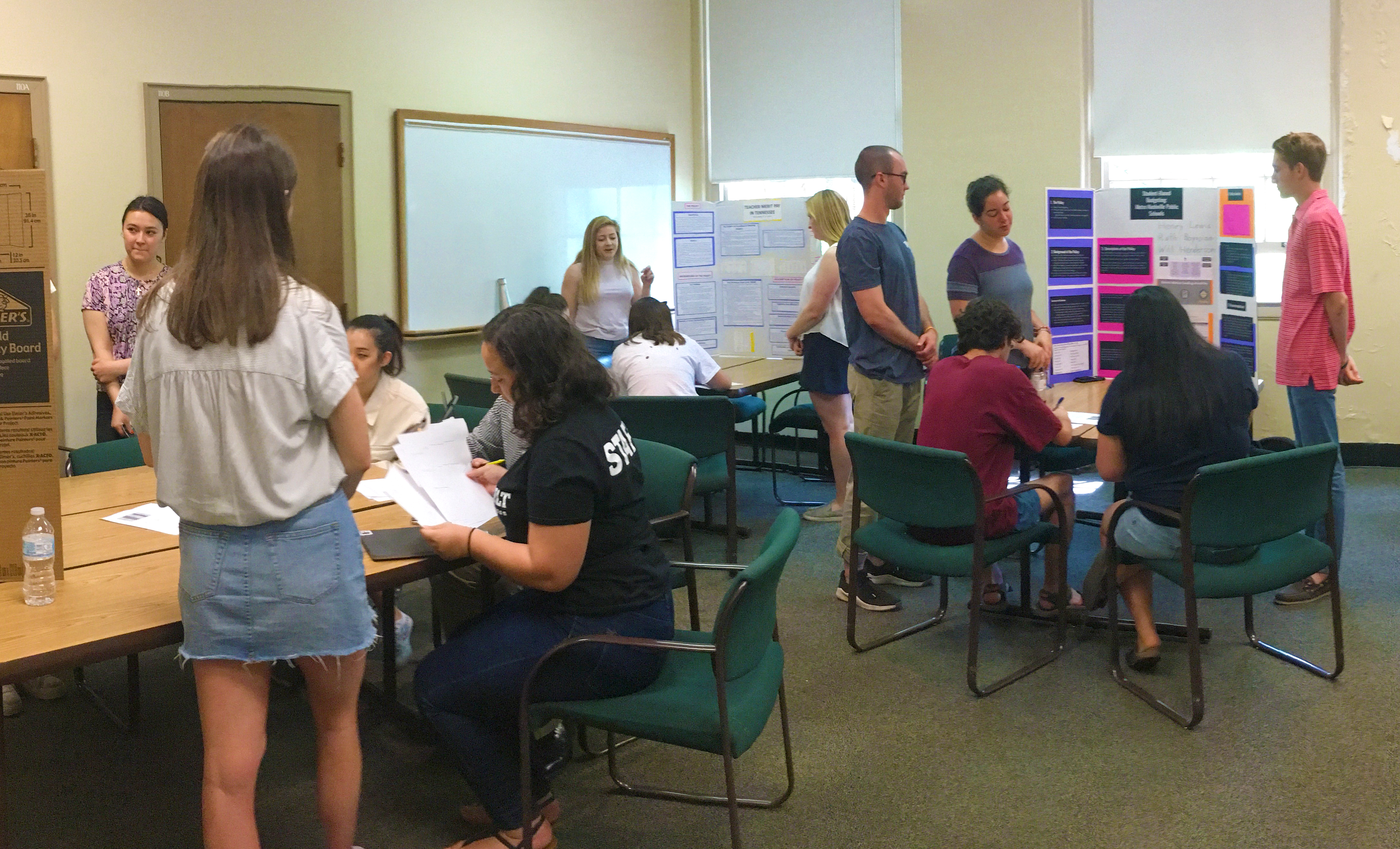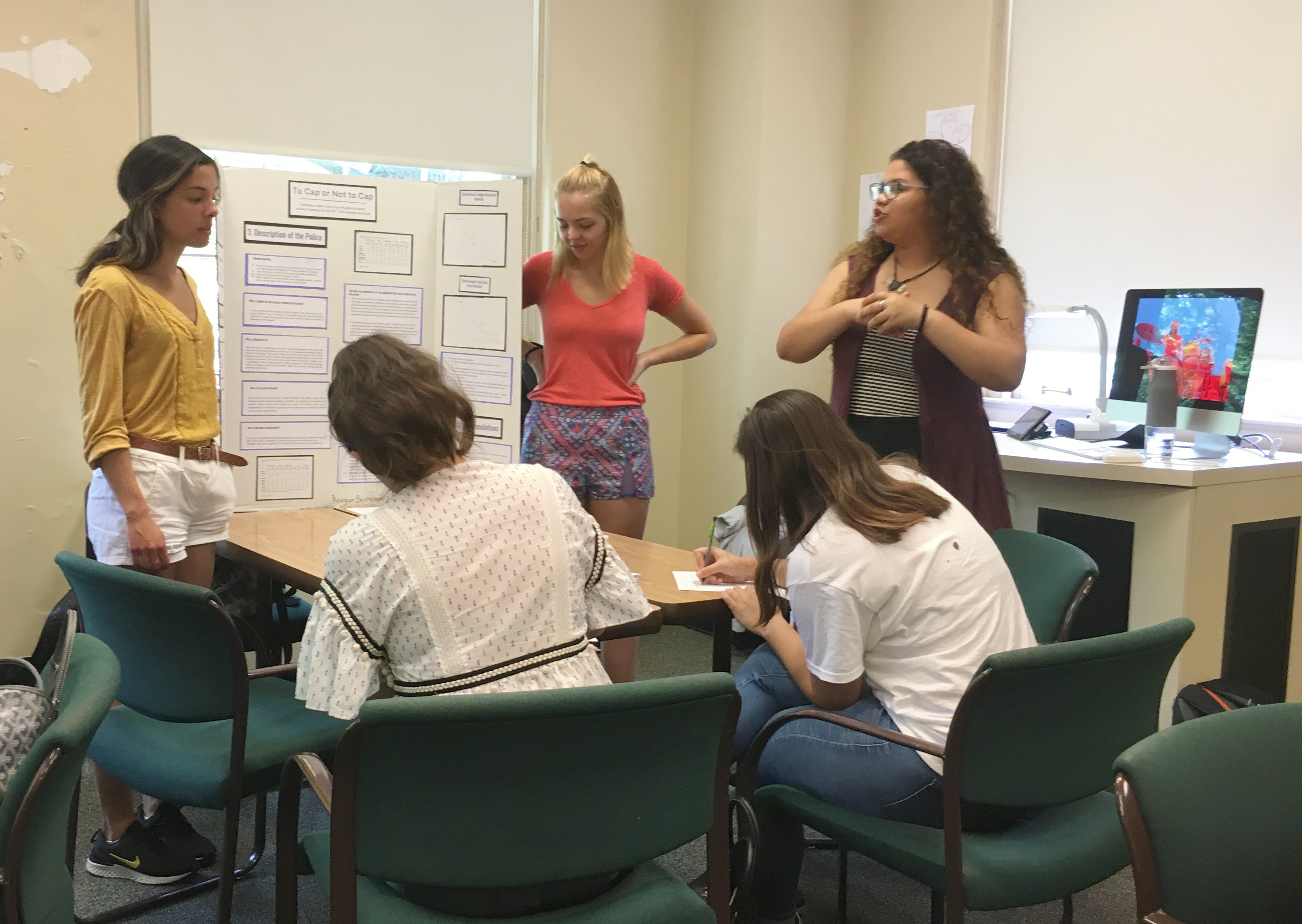Teaching Innovations at Vanderbilt: Chris Candelaria and Poster Sessions
By Faith Rovenolt, CFT undergraduate intern
For the first time in this blog series, I was able to go and see the teaching innovation I would write about. During 2019 Spring semester, I visited the end-of-semester poster sessions held for HODE 3225: Introduction to Public Finance of Education, which is taught by Chris Candelaria. Candelaria is an Assistant Professor of Public Policy and Education in the Department of Leadership, Policy, and Organizations in Peabody College.
 When Candelaria first taught this course three years ago, he had his students prepare a final presentation using PowerPoint. He observed that students were not particularly engaged with the format: students had a single opportunity to present to their peers and address a few questions; all the work students had done to prepare for the final presentation was condensed into 12 minutes. Inspired by colleagues in other departments like Computer Science and Mathematics—and also motivated by wanting to engage students’ interests more—Candelaria switched to having students give poster presentations. Students form groups and choose a policy topic to focus on, ranging from universal pre-K to charter school caps. Then, they analyze the policy using economic theories and models learned in the course and give recommendations for their policy based on their analyses. In preparation for the presentation, the students use Diigo to store and disperse papers (a practice Candelaria adopted on the recommendation of Corbette Doyle).
When Candelaria first taught this course three years ago, he had his students prepare a final presentation using PowerPoint. He observed that students were not particularly engaged with the format: students had a single opportunity to present to their peers and address a few questions; all the work students had done to prepare for the final presentation was condensed into 12 minutes. Inspired by colleagues in other departments like Computer Science and Mathematics—and also motivated by wanting to engage students’ interests more—Candelaria switched to having students give poster presentations. Students form groups and choose a policy topic to focus on, ranging from universal pre-K to charter school caps. Then, they analyze the policy using economic theories and models learned in the course and give recommendations for their policy based on their analyses. In preparation for the presentation, the students use Diigo to store and disperse papers (a practice Candelaria adopted on the recommendation of Corbette Doyle).
Two class days are dedicated to the students’ poster presentations, with one-half of the students presenting and the other half evaluating one day and switching the next. Each group has twelve minutes to present, which includes plenty of time for questions.
The setup is intentionally like a poster session you would see at a conference, with presenters discussing their poster multiple times as new people come by. That way, it not only mimics a real-life scenario, but it also gives students several chances to present. In fact, between each poster session rotation, Candelaria would call out to the class things like “Each time is a new opportunity. How might you revise your approach with your new audience?” He mentioned that the first time a group gave a presentation would likely not be as good as their last, and he encouraged them to modify and hone as they went.
Poster presentations, then, allow students to:
- gain multiple chances to present
- hone and modify their presentation skills
- be selective about what to put on a poster, as there is limited physical space
- engage with the audience in smaller discussion groups rather than presenting to the whole class at once
 As each poster session round went on, Candelaria heard back from the presenting students that it was getting easier. Other feedback, collected through a peer evaluation form, was informative as well. All students who listen and interact with the presenting groups fill out these forms, with the goal of providing constructive feedback. The evaluation form requires students to comment on the presenters’ strengths; the forms also encourage students to give suggestions on how their peers can improve with respect to content or presentation style.
As each poster session round went on, Candelaria heard back from the presenting students that it was getting easier. Other feedback, collected through a peer evaluation form, was informative as well. All students who listen and interact with the presenting groups fill out these forms, with the goal of providing constructive feedback. The evaluation form requires students to comment on the presenters’ strengths; the forms also encourage students to give suggestions on how their peers can improve with respect to content or presentation style.
In the future, Candelaria would love to have a bigger space to conduct these poster sessions—this time he did it in his normally scheduled classroom, showing that it is possible to do this with limited room. But he’d still love to have larger space and also invite other people, making it a public event on campus. He’d also love to be able to pay for students to print out professional posters rather than just providing them with trifolds that they can glue paper to.
This is an easily applicable assignment to almost any course, and Candelaria feels it is especially helpful for courses that cover a large amount of information but that can’t go into each of the topics students might be interested in.
This project is part of the course redesign that Candelaria did as a Junior Faculty Teaching Fellow, when he reshaped the course around six key questions related to the public financing of education. Vanderbilt faculty and graduate students who are interested in a course (re)design experience focused on “students-as-producers” kinds of projects like Candelaria’s should consider the CFT’s Course Design Institutes.
.

Leave a Response